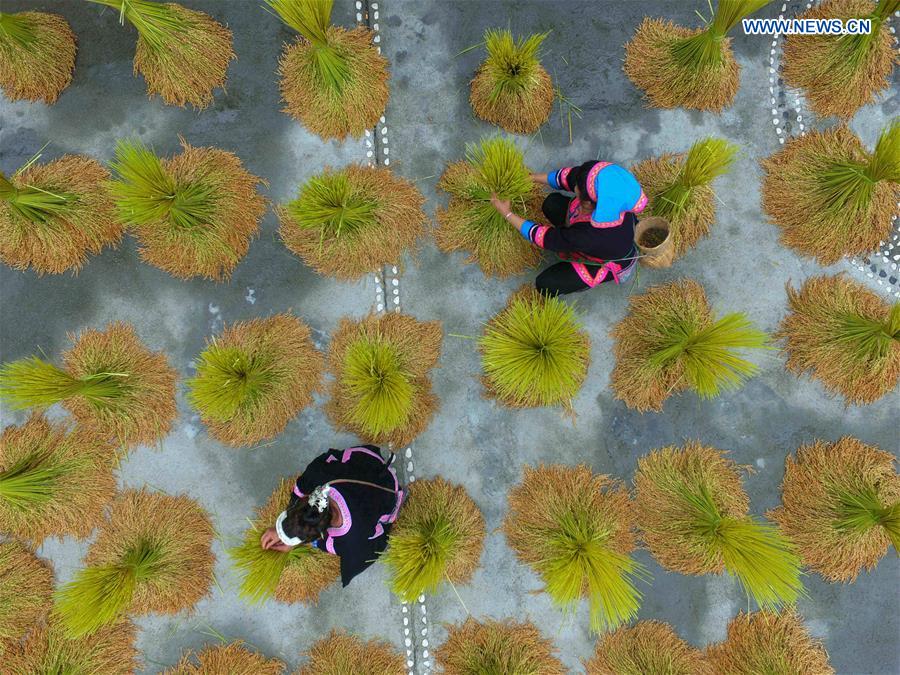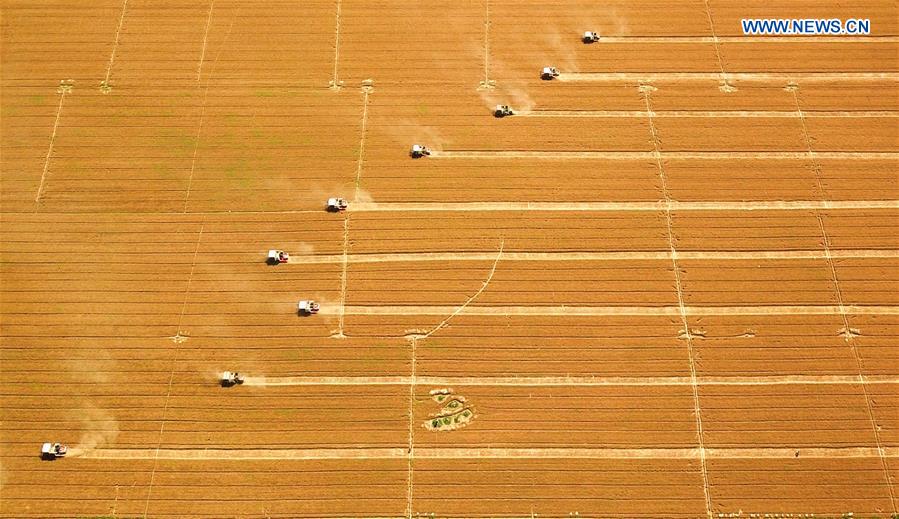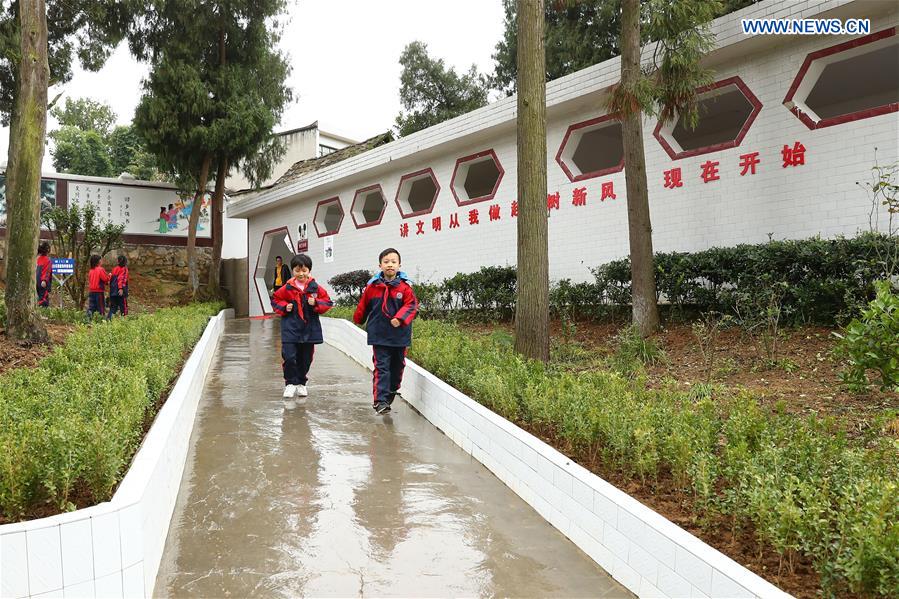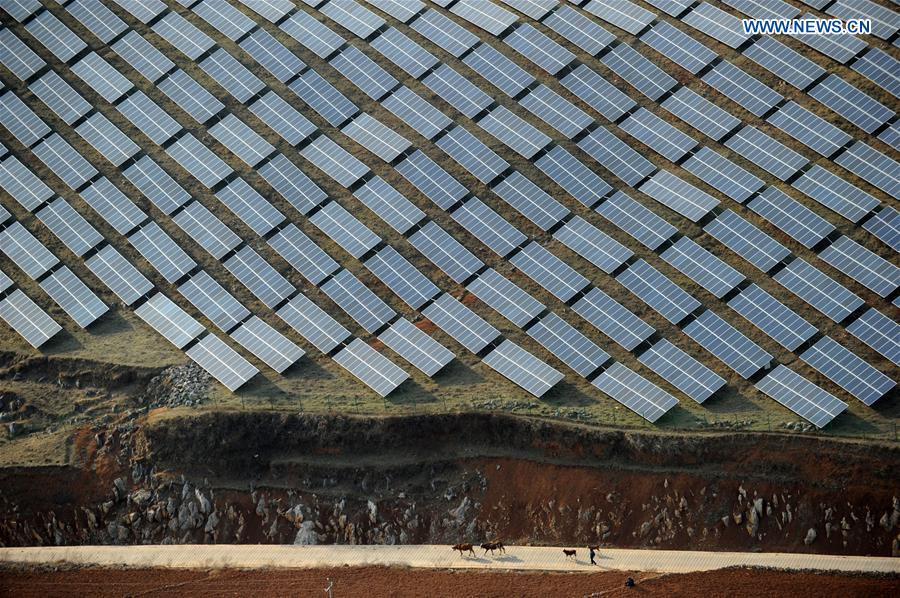
A child prepares to put trash into a classified garbage bin at Gangkou Village of Anji County, east China's Zhejiang Province, Aug. 16, 2018. In addition to education and healthcare, the Chinese government is also turning its attention to something equally important to rural areas: toilets. The world's second-largest economy is in the midst of a "toilet revolution," launched in 2015 to improve restrooms across the country. China has announced plans to install or renovate toilets for 10 million rural households in 30,000 villages this year. The fund allocation by the central government is expected to be 7 billion yuan (about 1.04 billion U.S. dollars). Toilet revolution is just part of a much grander rural revitalization strategy, first put forward during the 19th National Congress of the Communist Party of China in 2017 and repeatedly stressed by the Chinese leadership since then. The strategy aims at achieving the basic modernization of agriculture and rural areas by 2035, and the grand goal of a strong agriculture, a beautiful countryside and well-off farmers by 2050. (Xinhua/Zhang Chen)

Villagers air rice crops at a village in Pingdeng Town of Longsheng County, south China's Guangxi Zhuang Autonomous Region, on Oct. 11, 2018. In addition to education and healthcare, the Chinese government is also turning its attention to something equally important to rural areas: toilets. The world's second-largest economy is in the midst of a "toilet revolution," launched in 2015 to improve restrooms across the country. China has announced plans to install or renovate toilets for 10 million rural households in 30,000 villages this year. The fund allocation by the central government is expected to be 7 billion yuan (about 1.04 billion U.S. dollars). Toilet revolution is just part of a much grander rural revitalization strategy, first put forward during the 19th National Congress of the Communist Party of China in 2017 and repeatedly stressed by the Chinese leadership since then. The strategy aims at achieving the basic modernization of agriculture and rural areas by 2035, and the grand goal of a strong agriculture, a beautiful countryside and well-off farmers by 2050. (Xinhua/Huang Yongdan)

Harvesters reap wheat at a farm in Xichen Village of Jiangwucheng Township in Cixian County, north China's Hebei Province, June 5, 2018. In addition to education and healthcare, the Chinese government is also turning its attention to something equally important to rural areas: toilets. The world's second-largest economy is in the midst of a "toilet revolution," launched in 2015 to improve restrooms across the country. China has announced plans to install or renovate toilets for 10 million rural households in 30,000 villages this year. The fund allocation by the central government is expected to be 7 billion yuan (about 1.04 billion U.S. dollars). Toilet revolution is just part of a much grander rural revitalization strategy, first put forward during the 19th National Congress of the Communist Party of China in 2017 and repeatedly stressed by the Chinese leadership since then. The strategy aims at achieving the basic modernization of agriculture and rural areas by 2035, and the grand goal of a strong agriculture, a beautiful countryside and well-off farmers by 2050. (Xinhua/Wang Xiao)

Students walk past the newly-built flush toilet at a primary school in Zhijin County, southwest China's Guizhou Province, Oct. 23, 2018. In addition to education and healthcare, the Chinese government is also turning its attention to something equally important to rural areas: toilets. The world's second-largest economy is in the midst of a "toilet revolution," launched in 2015 to improve restrooms across the country. China has announced plans to install or renovate toilets for 10 million rural households in 30,000 villages this year. The fund allocation by the central government is expected to be 7 billion yuan (about 1.04 billion U.S. dollars). Toilet revolution is just part of a much grander rural revitalization strategy, first put forward during the 19th National Congress of the Communist Party of China in 2017 and repeatedly stressed by the Chinese leadership since then. The strategy aims at achieving the basic modernization of agriculture and rural areas by 2035, and the grand goal of a strong agriculture, a beautiful countryside and well-off farmers by 2050. (Xinhua/Zhang Yuwei)

Photo taken on Dec. 5, 2017 shows a public toilet in Xijiang Qianhu Miao Village in Leishan County, southwest China's Guizhou Province. In addition to education and healthcare, the Chinese government is also turning its attention to something equally important to rural areas: toilets. The world's second-largest economy is in the midst of a "toilet revolution," launched in 2015 to improve restrooms across the country. China has announced plans to install or renovate toilets for 10 million rural households in 30,000 villages this year. The fund allocation by the central government is expected to be 7 billion yuan (about 1.04 billion U.S. dollars). Toilet revolution is just part of a much grander rural revitalization strategy, first put forward during the 19th National Congress of the Communist Party of China in 2017 and repeatedly stressed by the Chinese leadership since then. The strategy aims at achieving the basic modernization of agriculture and rural areas by 2035, and the grand goal of a strong agriculture, a beautiful countryside and well-off farmers by 2050. (Xinhua/Cai Xingwen)

Aerial photo taken on Sept. 26, 2018 shows rice fields at Xiaogang Village in Fengyang County, east China's Anhui Province. In addition to education and healthcare, the Chinese government is also turning its attention to something equally important to rural areas: toilets. The world's second-largest economy is in the midst of a "toilet revolution," launched in 2015 to improve restrooms across the country. China has announced plans to install or renovate toilets for 10 million rural households in 30,000 villages this year. The fund allocation by the central government is expected to be 7 billion yuan (about 1.04 billion U.S. dollars). Toilet revolution is just part of a much grander rural revitalization strategy, first put forward during the 19th National Congress of the Communist Party of China in 2017 and repeatedly stressed by the Chinese leadership since then. The strategy aims at achieving the basic modernization of agriculture and rural areas by 2035, and the grand goal of a strong agriculture, a beautiful countryside and well-off farmers by 2050. (Xinhua/Liu Junxi)

A villager walks past the Pingjing photovoltaic (PV) power station in Weining County, southwest China's Guizhou Province, March 13, 2018. In addition to education and healthcare, the Chinese government is also turning its attention to something equally important to rural areas: toilets. The world's second-largest economy is in the midst of a "toilet revolution," launched in 2015 to improve restrooms across the country. China has announced plans to install or renovate toilets for 10 million rural households in 30,000 villages this year. The fund allocation by the central government is expected to be 7 billion yuan (about 1.04 billion U.S. dollars). Toilet revolution is just part of a much grander rural revitalization strategy, first put forward during the 19th National Congress of the Communist Party of China in 2017 and repeatedly stressed by the Chinese leadership since then. The strategy aims at achieving the basic modernization of agriculture and rural areas by 2035, and the grand goal of a strong agriculture, a beautiful countryside and well-off farmers by 2050. (Xinhua/Yang Wenbin)
